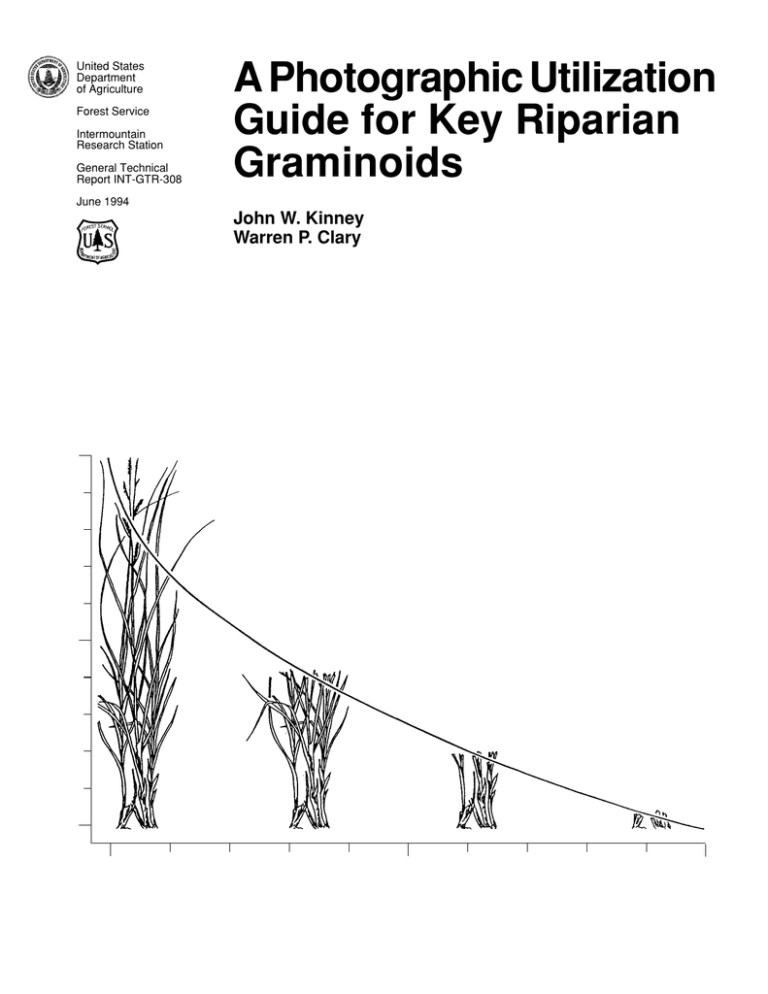A Photographic Utilization Guide for Key Riparian Graminoids
advertisement

United States Department of Agriculture Forest Service Intermountain Research Station General Technical Report INT-GTR-308 A Photographic Utilization Guide for Key Riparian Graminoids June 1994 John W. Kinney Warren P. Clary The Authors John W. Kinney is Range Technician with the Intermountain Research Station’s Riparian-Stream Ecology and Management Research Work Unit at Boise, ID. He received a B.S. degree in botany from Weber State College. He joined the Forest Service in 1975 and was stationed at the Desert Experimental Range in Utah for 9 years. He joined the riparian-stream unit in 1984. Warren P. Clary is Project Leader of the Intermountain Research Station’s Riparian-Stream Ecology and Management Research Work Unit at Boise, ID. He received a B.S. degree in agriculture from the University of Nebraska, an M.S. degree in range management, and a Ph.D. degree in botany (plant ecology) from Colorado State University. He joined the Forest Service in 1960 and conducted research on rangelands in Arizona, Louisiana, and Utah. Most recently he has focused on riparian-livestock grazing issues in Idaho, Oregon, and Nevada. Acknowledgments We gratefully acknowledge the assistance of Leroy Alonzo, Fred Galan, Mering Hurd, and Lynda Smithman. Suggestions by Warren Ririe and Alma Winward at the initiation of this effort are greatly appeciated. The cover illustration was drawn by Lenora Oosterhuis, an emigrant from Holland, who is a botanist and a freelance biological artist living in Boise, ID. Intermountain Research Station 324 25th Street Ogden, UT 84401 A Photographic Utilization Guide for Key Riparian Graminoids John W. Kinney Warren P. Clary Introduction Background Determining proper utilization of forage is one of the most important activities in range management. Consequently, range technicians have spent a lot of time studying forage utilization and ways to measure utilization (Cook and Stubbendieck 1986; Schmutz and others 1963). Various methods have been developed. Some are quicker, while others take longer but are more detailed and accurate. A quick and easy method to estimate plant utilization is needed because many range managers must survey large areas. One such method, the grazed-class method, uses photographic guides (Schmutz and others 1963). Cattle and most large grazing animals are attracted to riparian areas (Skovlin 1984) (fig. 1). It is, therefore, particularly important to monitor utilization in riparian areas. A search of the literature revealed no photographic guides available to estimate percent utilization for riparian plant species. We have developed photographic guides for several key riparian grass and grasslike species to help determine forage utilization. Data and photographs for these guides were gathered on the Boise and Sawtooth National Forests, Boise and Vale Districts of the Bureau of Land Management, and on Idaho State land. The grazed-class method provides a visual comparison standard, making utilization estimates more consistent and accurate. Estimates of utilization are based on the growth form of the plant rather than on its size. Variations in height growth due to site characteristics, seasonal precipitation, or other factors have minimal effect on utilization estimates (Schmutz 1971). Lommasson and Jensen (1938, 1943) found each plant species had a more or less definite growth form, even though growing conditions may vary. Various growth forms have been illustrated by Campbell (1943), Caird (1945), and McDougald and Platt (1976). For a given growth form, the relationship between the percent of a plant’s weight that has been consumed can be estimated based on the percent of its height left after grazing. Mitchell and others (1993) found height-weight relationships of western wheatgrass were affected somewhat by location, grazing history, and season. However, most differences were small. The authors concluded height-weight models allow managers to assess utilization efficiently. Development of Photographic Utilization Guides Photographic guides should relate the appearance of a plant after a given portion of its weight has been removed to the height-weight curve (Schmutz and others 1963) (fig. 2). The first task is determining how the weight is vertically distributed for each species (Cook and Stubbendieck 1986). Initially, our approach followed that of Schmutz and others (1963). However, their procedure was developed primarily for use on bunchgrasses. In riparian areas the plants are typically sod formers. We soon found that selection of individual “plants” with flowering heads resulted in a biased sample, since many tillers (shoots) in dense meadows did not produce a flowering stem. The procedure was modified to use 10-cm-square sections of sod as the sample unit rather than individual plants. Figure 1—Cattle are attracted to riparian areas. 1 Percent Height Remaining 100 50 0 0 50 100 Percent Weight Removed Figure 2—The relationship of percent height remaining and percent weight removed for grazed plants. Figure 3—Photographic setup when taking pictures for the photographic utilization guide. Methods starting from the top, removing the sections in sequence. Each section was placed into a paper bag, labeled, and ovendried at 100 °C for 24 hours. The sections were weighed to the nearest 0.1 g, and the percentages of total plant weight were calculated. The heights of the species studied are illustrated in table 1. Plant numbers 1, 5, 10, 15, 20, and 25 were photographed for potential use in illustrating the photographic guide. The sod was clipped to ground level at each side and in front of the target plant for a distance of 0.5 m. The plants were photographed using a tripod with the camera mounted at constant angle, distance from the plant, and height. A black backdrop was placed behind the plant (fig. 3). A sequence of photographs was taken beginning at the unclipped stage and continuing as each linear section was removed. The weight distribution was determined as described above. The cumulative weight for each plant was determined for each clipped section removed, and cumulative weight percentages were calculated. The percent height remaining was plotted against the percentage of cumulative weight removed. All clipped plant data for a given species were plotted on the same chart; the relationship was described by an ocularly fitted curve. From the chart curves, the average remaining height percentage was determined for each of the grazed classes—0, 10, 30, 50, 70, and 90 percent. Photographed plant sequences selected for use in the photographic guide had average deviations from the height-weight curve of less than 3 percent. If a close match was not obtained initially, additional typical plants were photographed until a close fit was secured. After plants were fully headed, 25 representative 10- by 10-cm areas of sod (called plants in this discussion) were selected from a typical site or sites. Any tillers of nontarget species were removed. The plant’s height was measured and divided into 10 to 20 equal linear sections. The plant was clipped Table 1—Heights of plant species sampled Plant species Mean Height Minimum Maximum - - - - - - - - - - - -cm - - - - - - - - - - Redtop bentgrass (Agrostis stolonifera) Bluejoint reedgrass (Calamagrostis canadensis) Water sedge (Carex aquatilis) Smallwing sedge (Carex microptera) Nebraska sedge (Carex nebrascensis) Beaked sedge (Carex rostrata) Tufted hairgrass (Deschampsia cespitosa) Baltic rush (Juncus balticus) Kentucky bluegrass (Poa pratensis) 73 58 84 74 60 90 55 35 68 35 30 40 54 47 62 61 48 72 35 28 44 74 51 92 44 23 78 2 Field Application (Juncus balticus), and Kentucky bluegrass (Poa pratensis). The scientific nomenclature follows Cronquist and others (1977). Photographic utilization guides can be used effectively with little formal training. Instruction should include both theory and field practice. Otherwise, inexperienced users may tend to overestimate utilization when grazing is light (Boyd 1987) and underestimate utilization when grazing is heavy (Schmutz 1971). For more precise documentation of utilization, the height of local species before grazing can be determined, residual stubble heights can be measured, and the percent weight removed can be determined from the graphs in the appendix. The use of photographic guides is based on the appearance of the residual portion of the grazed plant. Therefore, to estimate the utilization of an individual plant, its residual stubble is visually compared to the photographic guide in the appendix. A number of individual utilization determinations are needed to reliably estimate average utilization in an area. “Substantial” statistical precision from a 50- to 100-plant sample within a homogeneous sample area has been reported (Kingery and others 1992; Schmutz 1971). Further suggestions on procedures for using a photographic guide can be found in Schmutz and others (1963), Schmutz (1971), and Kingery and others (1992). Precise documentation of utilization requires additional effort. No absolute plant heights were included in the illustrations because height varies within plant species among sites and years. A plant height standard should be established for each species in a locality. The number of plant measurements necessary to develop a local standard will vary with the precision required and the variability of the plant population being measured. Based on our data, about 25 random plant height measurements should give mean plant height estimates within 5 percent of the mean at 95 percent confidence (table 2). After a local mean species height has been established, it can be used to calculate the proportion of height remaining on each grazed sample plant. The proportion of weight removed can be determined from the graphs in the appendix. References Boyd, Carol. 1987. Evaluation of the grazed-class method for estimating forage utilization on transitory rangelands in northern Idaho. Moscow, ID: University of Idaho. 137 p. Thesis. Caird, Ralph W. 1945. Influence of site and grazing intensity on yields of grass forage in the Texas Panhandle. Journal of Forestry. 43(1): 45-49. Campbell, R. S. 1943. Progress in utilization standards for western ranges. Journal of the Washington Academy of Sciences. 33: 161-169. Cook, C. Wayne; Stubbendieck, James, eds. 1986. Range research: basic problems and techniques. Denver, CO: Society for Range Management. 317 p. Cronquist, Arthur; Holmgren, Arthur H.; Holmgren, Noel H.; Reveal, James L.; Holmgren, Patricia K. 1977. Intermountain flora: vascular plants of the Intermountain West, U.S.A. Vol. 6. New York: Columbia University Press. 584 p. Kingery, James L.; Boyd, Carol; Kingery, Peggy E. 1992. The grazed-class method to estimate forage utilization on transitory forest rangelands. Stn. Bull. 54. Moscow, ID: University of Idaho, College of Forestry, Wildlife and Range Sciences, Idaho Forest, Wildlife and Range Experiment Station. 21 p. Lommasson, Tom; Jensen, Chandler. 1938. Grass volume tables for determining range utilization. Science. 87: 444. Lommasson, T.; Jensen, Chandler. 1943. Determining utilization of range grasses from height-weight tables. Journal of Forestry. 41(8): 589-593. McDougald, Neil K.; Platt, Richard C. 1976. A method of determining utilization for wet mountain meadows on the Summit Allotment, Sequoia National Forest, California. Journal of Range Management. 29(6): 497-501. Mitchell, John E.; Elderkin, Robert; Lewis, James K. 1993. Seasonal height-weight dynamics of western wheatgrass. Journal of Range Management. 46: 147-151. Summary The photographic utilization guides in the appendix are the first available for riparian herbaceous forage species in the Intermountain area. They include: redtop bentgrass (Agrostis stolonifera), water sedge (Carex aquatilis), smallwing sedge (C. microptera), Nebraska sedge (C. nebrascensis), beaked sedge (C. rostrata), bluejoint reedgrass (Calamagrostis canadensis), tufted hairgrass (Deschampsia cespitosa), Baltic rush Table 2—Average number of plant height measurements needed to establish local standards1 Sampling error (percent of maximum height) 0.80 10 5 1 2 10 247 Confidence level 0.85 0.90 0.95 3 13 312 4 16 407 6 23 578 0.99 10 40 998 1 Based on the pooled variance of all species sampled. 3 Schmutz, Ervin M. 1971. Estimation of range use with grazed-class photo guides. Bull. A-73. Tucson, AZ: University of Arizona, Cooperative Extension Service and Agricultural Experiment Station. 16 p. Schmutz, Ervin M.; Holt, Gary A.; Michaels, Charles C. 1963. Grazed-class method of estimating forage utilization. Journal of Range Management. 16(2): 54-60. Skovlin, Jon M. 1984. Impact of grazing on wetlands and riparian habitat: a review of our knowledge. In: Developing strategies for rangeland management. Boulder, CO: Westview Press: 1001-1103. 4 Percent Height Remaining 5 0 10 20 30 40 50 60 70 80 90 100 0 10 20 0 40 50 60 70 Percent Weight Removed 30 10 80 90 100 30 50 70 90 Low to middle elevations Streambanks, meadows, and moderately moist sagebrush slopes Palatability moderate Seed set August Flowering period mid-June to early August 4 to 10 dm tall Rhizomatous or stoloniferous perennials Percent Weight Removed Redtop bentgrass (Agrostis stolonifera L.) Appendix: Photographic Guides and Height-Weight Curves for Nine Riparian Species 6 Percent Height Remaining 0 10 20 30 40 20 30 40 50 60 70 80 90 100 Percent Weight Removed Low to high elevations Wet meadows, forest openings, and streambanks Flowering period July to August 6 to 12 dm tall 50 10 90 Palatability medium when young; tough and unpalatable when mature 0 70 Strongly rhizomatous perennials, culms stout, panicle loosely branched and rather open 50 60 30 Seed set August 10 70 80 90 100 0 Percent Weight Removed Bluejoint reedgrass (Calamagrostis canadensis Michx.) 7 Percent Height Remaining 0 10 20 30 20 30 40 50 60 70 Percent Weight Removed 80 90 100 Middle elevations Common in shallow water or wet soil, and on streambanks 50 40 Palatability moderate 60 3 to 10 dm tall Seed set August 10 70 90 Stems borne singly or a few together on well-developed, stout, deep-seated, creeping rhizomes 50 70 30 Flowering period July to September 0 10 80 90 100 0 Percent Weight Removed Water sedge (Carex aquatilis Wahlenb.) 8 Percent Height Remaining 0 10 20 30 40 50 60 70 80 90 100 0 10 0 20 40 50 60 70 Percent Weight Removed 30 10 80 90 100 30 70 Foothills to moderately high elevations Moderately dry sites, in meadows and along streams Palatability low to medium Seed set August Flowering period July to early September 3 to 10 dm tall Plants densely tufted, without creeping rhizomes, culms numerous 50 Percent Weight Removed Smallwing sedge (Carex microptera Mack.) 90 9 Percent Height Remaining 0 10 20 30 40 20 30 40 50 60 70 Percent Weight Removed 80 90 100 Lower to middle elevations Wet meadows and other wet places, often in alkaline areas 50 Flowering period July to September 2 to 10 dm tall Palatability high 10 70 90 Plants coarse, stems stout and sharply triangular, vigorously rhizomatous, leaves firm, blue-glaucous 50 60 30 Seed set August 0 10 70 80 90 100 0 Percent Weight Removed Nebraska sedge (Carex nebrascensis Dewey) 10 Percent Height Remaining 10 20 30 40 50 60 70 80 90 100 90 Seed set August Flowering period July to September 6 to 12 dm tall 0 10 20 30 40 Percent Weight Removed Middle to high elevations Common in wet meadows and marshes, or in standing or slow-moving water 0 70 Stems singly or a few together from stout rhizomes, sometimes forming a dense sod 50 50 30 Palatability low late in the season 10 60 70 80 90 100 0 Percent Weight Removed Beaked sedge (Carex rostrata Stokes) 11 Percent Height Remaining 0 10 20 30 40 50 60 70 80 90 100 0 10 0 20 40 50 60 70 Percent Weight Removed 30 10 80 90 100 30 70 Middle to high elevations Streambanks and wet mountain meadows to dry uplands Palatability moderate Seed set August to September Flowering period July to September 2 to 8 dm tall Strongly cespitose, tufted perennials with an open panicle 50 Percent Weight Removed Tufted hairgrass (Deschampsia cespitosa L.) 90 12 Percent Height Remaining 10 20 30 40 50 60 70 80 90 100 Seed set July Flowering period May to July 3 to 9 dm tall 0 10 20 30 40 Percent Weight Removed Valleys and plains to middle elevations Low, wet, often alkaline areas with variable water tables 0 70 90 Stems firm, wiry, and more or less terete (cylindrical); coarse, blackish, creeping rhizomes are often sod forming 50 50 30 Palatability moderately low 10 60 70 80 90 100 0 Percent Weight Removed Baltic rush (Juncus balticus Willd.) 13 Percent Height Remaining 0 10 20 30 40 50 0 10 20 30 40 50 60 70 Percent Weight Removed 80 90 100 Most elevations Moderately moist to dry meadows and open woods Palatability high 60 70 Seed set August 3 to 7 dm tall Perennials forming dense sods 50 70 30 Flowering period May to August, sometimes September 10 80 90 100 0 Percent Weight Removed Kentucky bluegrass (Poa pratensis L.) 90 Kinney, John W.; Clary, Warren P. 1994. A photographic utilization guide for key riparian graminoids. Gen. Tech. Rep. INT-GTR-308. Ogden, UT: U.S. Department of Agriculture, Forest Service, Intermountain Research Station. 13 p. Photographic guides are presented to help estimate grazing utilization of important riparian grasses and grasslike plants. Graphs showing the percent of a plant’s weight that has been consumed based on the percent of its height left after grazing allow utilization estimates to be refined further. Keywords: grazing, grazing effects, grazing intensity, grasses, sedges, rushes INTERMOUNTAIN RESEARCH STATION The Intermountain Research Station provides scientific knowledge and technology to improve management, protection, and use of the forests and rangelands of the Intermountain West. Research is designed to meet the needs of National Forest managers, Federal and State agencies, industry, academic institutions, public and private organizations, and individuals. Results of research are made available through publications, symposia, workshops, training sessions, and personal contacts. The Intermountain Research Station territory includes Montana, Idaho, Utah, Nevada, and western Wyoming. Eighty-five percent of the lands in the Station area, about 231 million acres, are classified as forest or rangeland. They include grasslands, deserts, shrublands, alpine areas, and forests. They provide fiber for forest industries, minerals and fossil fuels for energy and industrial development, water for domestic and industrial consumption, forage for livestock and wildlife, and recreation opportunities for millions of visitors. Several Station units conduct research in additional western States, or have missions that are national or international in scope. The policy of the United States Department of Agriculture Forest Service prohibits discrimination on the basis of race, color, national origin, age, religion, sex, or disability, familial status, or political affiliation. Persons believing they have been discriminated against in any Forest Service related activity should write to: Chief, Forest Service, USDA, P.O. Box 96090, Washington, DC 20090-6090. Federal Recycling Program Printed on Recycled Paper






